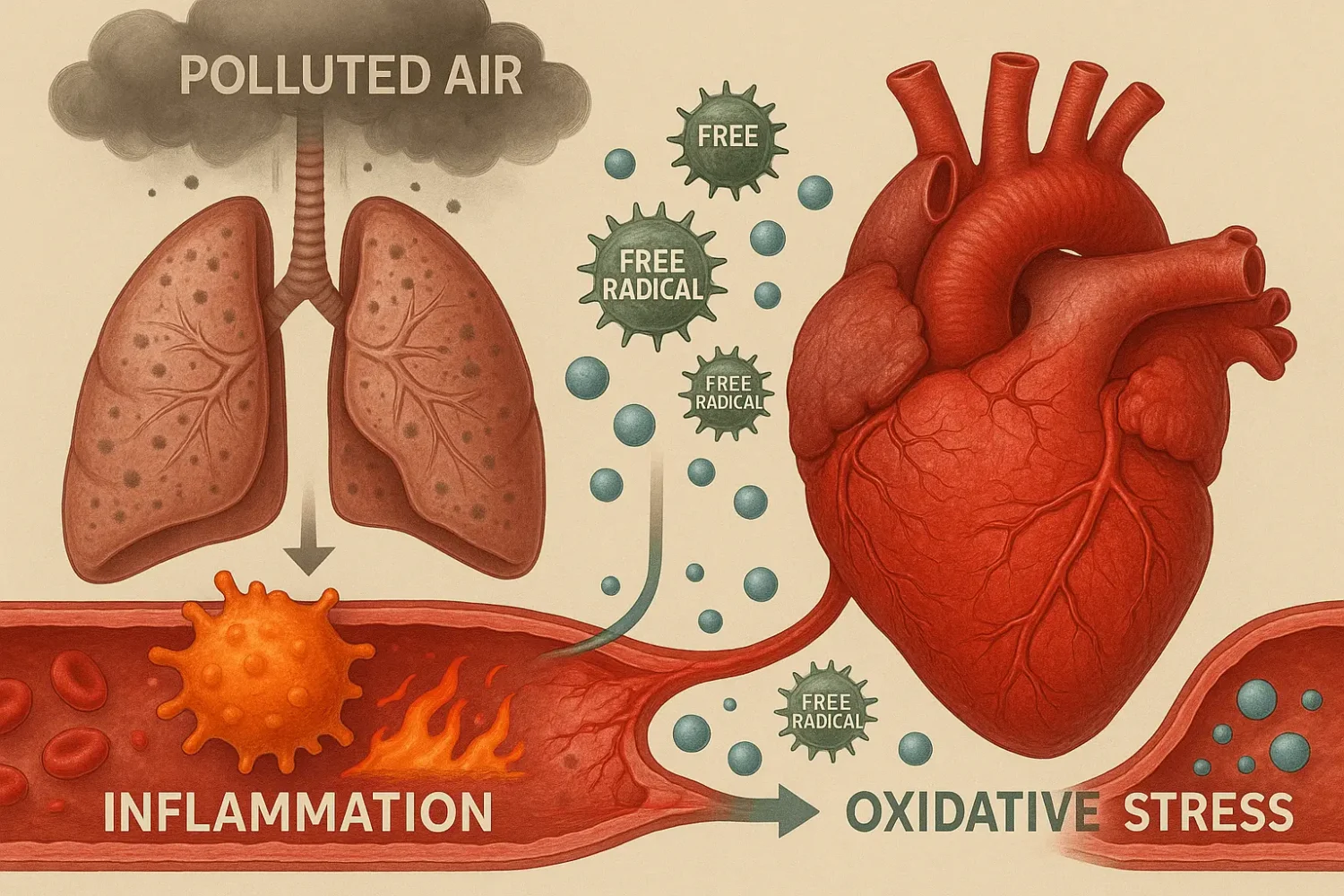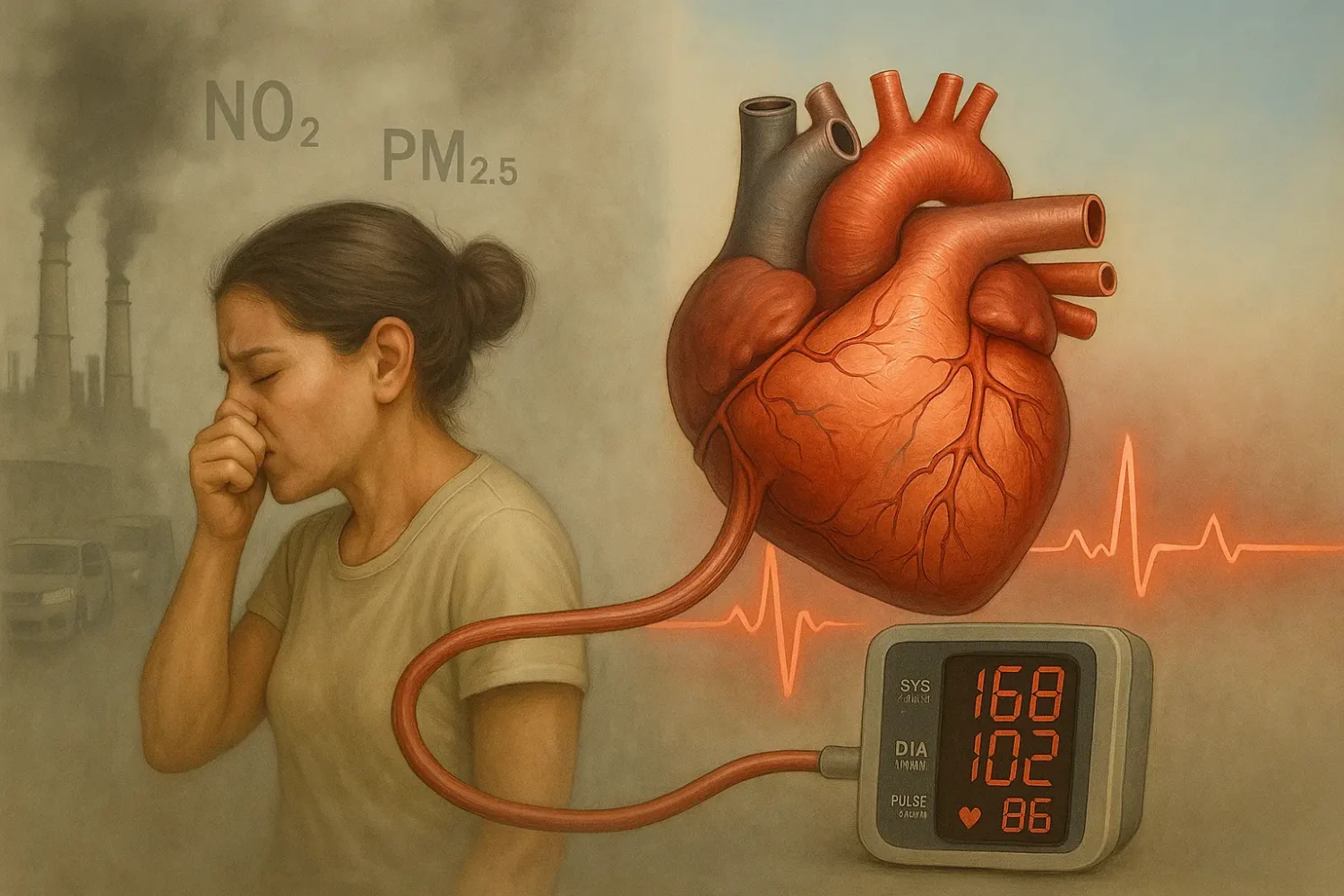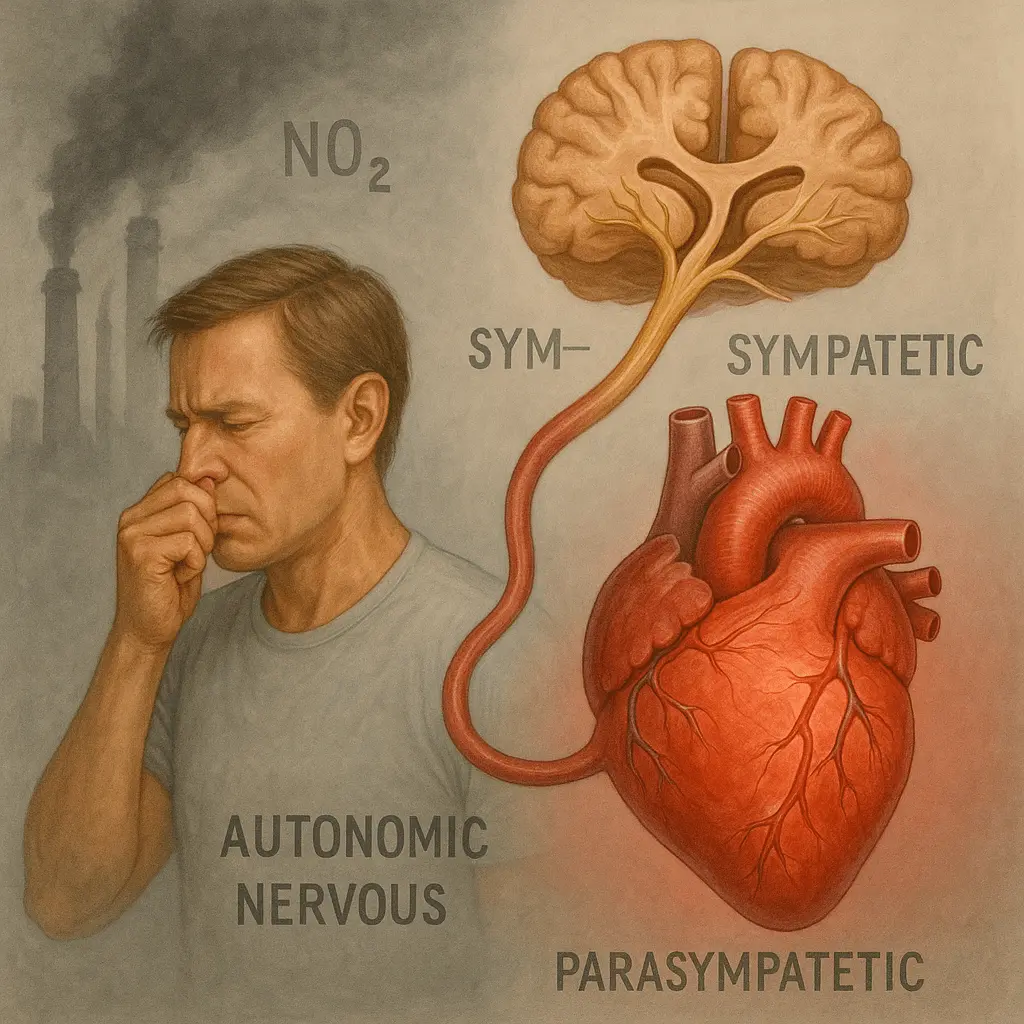Air pollution is one of the most significant environmental challenges of the 21st century. Since industrialization, urbanization, and vehicular emissions continue to grow, polluted air has become a major contributor to various health issues worldwide. While air pollution is widely recognized for its detrimental effects on the lungs, its impact on heart health is equally alarming. Thus, this article will explore the long-term exposure to polluted air and its impact on heart health, focusing on the mechanisms behind the damage, the global burden, and the statistics surrounding heart disease deaths linked to air pollution.
What is Air Pollution?
Air pollution refers to the presence of harmful substances in the atmosphere, including particulate matter (PM2.5, PM10), nitrogen dioxide (NO₂), sulfur dioxide (SO₂), carbon monoxide (CO), and ozone (O₃). These pollutants come from a variety of sources such as industrial emissions, vehicle exhaust, power plants, agricultural practices, and burning of fossil fuels.
Among the various pollutants, fine particulate matter (PM2.5), which is smaller than 2.5 micrometres in diameter, is particularly dangerous. Due to its tiny size, PM2.5 can penetrate deep into the lungs and enter the bloodstream, causing widespread harm to the body’s organs, including the heart.
The Link Between Air Pollution and Heart Health: Polluted Air and Its Impact on Heart Health
has been shown to increase the risk of developing a variety of heart conditions, such as coronary artery disease, heart attacks, heart failure, and strokes. Because, this occurs through several mechanisms:

1. Inflammation and Oxidative Stress
Fine particulate matter (PM2.5) from polluted air can penetrate deep into the lungs and enter the bloodstream. Once inside the body, these particles cause chronic inflammation and oxidative stress, both of which are key contributors to the development of cardiovascular diseases. Hence, the body’s immune system responds to the foreign particles by triggering inflammation, which leads to damage in the blood vessels.

Oxidative stress occurs when there is an imbalance between free radicals and antioxidants in the body. The free radicals, which are generated by pollutants in the air, damage the lining of blood vessels, hence this can result in endothelial dysfunction. As a result, this dysfunction impairs the ability of blood vessels to dilate and constrict, increasing blood pressure and putting additional strain on the heart.
2. Increased Blood Pressure
High blood pressure (hypertension) is a leading risk factor for heart disease, and moreover, exposure to air pollution is strongly associated with an increase in blood pressure. Furthermore, pollutants like nitrogen dioxide (NO₂) and particulate matter (PM2.5) have been found to trigger the release of stress hormones like cortisol, which in turn increase heart rate and blood pressure. As a result, chronic elevation in blood pressure causes damage to the heart and blood vessels, thereby increasing the likelihood of heart attacks, heart failure, and strokes.

3. Autonomic Nervous System Disruption
The autonomic nervous system controls automatic body functions like heart rate, blood pressure, and digestion. But, exposure to air pollution can upset the balance between its two parts: the sympathetic system (which prepares the body to fight or run) and the parasympathetic system (which helps the body rest and digest). As a result, this imbalance can cause irregular heartbeats (arrhythmias) and raise the risk of sudden heart problems.

4. Formation of Blood Clots
Air pollution, particularly fine particulate matter, has been linked to an increased risk of blood clot formation. Because these particles can activate platelets in the blood, making them stick together and form clots. Hence, these clots can block blood flow to the heart, leading to a heart attack or stroke.

Global Statistics and Data for Polluted Air and Its Impact on Heart Health
Air pollution is a significant global health threat, since millions of people suffer and die from cardiovascular diseases caused by long-term exposure to polluted air. According to the World Health Organization (WHO), outdoor air pollution is responsible for approximately 4.2 million premature deaths each year, of which a large portion is due to heart disease and stroke caused by fine particulate matter (PM2.5).
In fact, ischemic heart disease (which includes heart attacks) and stroke are the two leading causes of death attributable to air pollution globally.
Facts on the Impact of Air Pollution on Heart Disease:
• Approximately 1 in 8 deaths globally are attributed to air pollution-related cardiovascular diseases. This includes ischemic heart disease, strokes, and other cardiovascular complications linked to long-term exposure to pollutants like PM2.5.
• Notably, PM2.5 is responsible for the highest mortality rates due to its small size, which allows it to enter the bloodstream and cause inflammation, clotting, and damage to blood vessels. Therefore, it is considered one of the most dangerous air pollutants when it comes to heart health.
• Furthermore, developing regions, including South Asia, parts of Africa, and the Middle East, experience disproportionately high rates of deaths from ischemic heart disease and stroke due to air pollution exposure.
Heart Disease Deaths Linked to Air Pollution by Country:
Here is the data presented in a single, concise table, sorted by the percentage of deaths from ischemic heart disease attributable to outdoor fine particles (PM2.5). It highlights polluted air and its impact on heart health: Data source:
Note: The following country-level data represents deaths from ischemic heart disease attributable to outdoor fine particulate matter (PM2.5). These deaths make up 28% of all air pollution-related fatalities worldwide as of 2021, underscoring the heavy cardiovascular burden of polluted air globally.
Data Table:
| Sl.No. | Country | % Death | Sl.No. | Country | % Death |
| 1 | Qatar | 44% | 43 | Lebanon | 20% |
| 2 | Egypt | 41% | 44 | South Africa | 19% |
| 3 | Bahrain | 40% | 45 | Cuba | 19% |
| 4 | Saudi Arabia | 39% | 46 | Nigeria | 18% |
| 5 | Kuwait | 38% | 47 | Botswana | 18% |
| 6 | Oman | 35% | 48 | Nigeria | 18% |
| 7 | United Arab Emirates | 34% | 49 | Sri Lanka | 17% |
| 8 | Iraq | 32% | 50 | Bulgaria | 17% |
| 9 | Libya | 31% | 51 | Singapore | 17% |
| 10 | China | 29% | 52 | Georgia | 16% |
| 11 | Islamic Rep. of Iran | 29% | 53 | Angola | 16% |
| 12 | Armenia | 28% | 54 | Ukraine | 15% |
| 13 | Equatorial Guinea | 28% | 55 | Romania | 15% |
| 14 | Uzbekistan | 26% | 56 | Congo | 15% |
| 15 | Cabo Verde | 26% | 57 | Cyprus | 15% |
| 16 | Suriname | 26% | 58 | Mexico | 14% |
| 17 | State of Palestine | 26% | 59 | Colombia | 14% |
| 18 | Rep. of Korea | 25% | 60 | Italy | 14% |
| 19 | Syria | 25% | 61 | Venezuela | 14% |
| 20 | Peru | 25% | 62 | Argentina | 14% |
| 21 | Gabon | 25% | 63 | Tajikistan | 14% |
| 22 | Mongolia | 24% | 64 | Mexico | 14% |
| 23 | Bhutan | 24% | 65 | Guatemala | 13% |
| 24 | Algeria | 23% | 66 | Japan | 12% |
| 25 | Grenada | 23% | 67 | Timor-Leste | 10% |
| 26 | Trinidad and Tobago | 23% | 68 | Mali | 9% |
| 27 | Turkey | 23% | 69 | Honduras | 8% |
| 28 | Tunisia | 23% | 70 | Nicaragua | 8% |
| 29 | India | 23% | 71 | Seychelles | 8% |
| 30 | Tunisia | 23% | 72 | Zambia | 7% |
| 31 | Guyana | 22% | 73 | Afghanistan | 7% |
| 32 | Djibouti | 22% | 74 | Samoa | 7% |
| 33 | Saint Vincent and the Grenadines | 22% | 75 | Zambia | 7% |
| 34 | Saint Lucia | 22% | 76 | Liberia | 6% |
| 35 | Barbados | 22% | 77 | Uganda | 6% |
| 36 | Chile | 22% | 78 | Uganda | 6% |
| 37 | Bosnia and Herzegovina | 22% | 79 | Haiti | 4% |
| 38 | Azerbaijan | 21% | 80 | Zimbabwe | 4% |
| 39 | Serbia | 21% | 81 | Malawi | 3% |
| 40 | Belize | 21% | 82 | Rwanda | 3% |
| 41 | Mauritania | 21% | 83 | Somalia | 3% |
| 42 | Kazakhstan | 20% | 84 | Solomon Islands | 3% |
How Air Pollution Affects Vulnerable Populations
Certain populations are more susceptible to the cardiovascular effects of air pollution. These groups include:
• Elderly Individuals:
Firstly, older adults are more likely to have pre-existing heart conditions, making them more vulnerable to the effects of air pollution.
• Children:
Additionally, children’s developing cardiovascular systems are more sensitive to environmental pollutants. As a result, exposure during early childhood may lead to long-term cardiovascular risks in adulthood.
• People with Pre-existing Health Conditions:
Moreover, individuals with heart disease, diabetes, or hypertension are at higher risk of adverse health effects from polluted air.
• Low-Income Communities:
Finally, people living in lower-income neighborhoods often face higher levels of air pollution due to industrial activity, heavy traffic, and the lack of green spaces. Consequently, these communities also tend to have higher rates of heart disease and other chronic conditions.
Mitigation Strategies to Protect Heart Health
1. Regulation of Air Pollution:
First, governments should make stronger rules to limit pollution from factories, cars, and power plants. Also, they should encourage the use of clean and renewable energy to help lower pollution.
2. Urban Planning and Green Spaces:
Next, cities can reduce pollution by adding more parks and green areas, improving buses and trains, and cutting down on the number of cars. This helps people breathe cleaner air.
3. Public Awareness:
Also, health campaigns can teach people about the dangers of polluted air and how it harms the heart. For example, people should stay inside when pollution is high, use air purifiers at home, and wear masks if needed.
4. Health Monitoring:
It’s also important to study and track air pollution to see how it affects heart health over time. So, countries should invest in tools to check air quality and watch for early signs of heart problems.
5. Personal Protective Measures:
Finally, everyone should know how clean or dirty the air is where they live and take steps to stay safe. This means avoiding outdoor activities when pollution is bad, using air purifiers inside, and wearing masks if needed.
Key Insights:
- Developing regions like parts of Asia, Africa, and the Middle East have higher death rates from heart disease caused by air pollution. For example, Qatar (44%), Egypt (41%), and Bahrain (40%) are some of the countries with the highest numbers.
- Air pollution causes long-lasting inflammation and damage from harmful chemicals, which leads to serious heart problems.
- With 7 million deaths every year linked to air pollution, ischemic heart disease is one of the main causes of these deaths.
Conclusion
Breathing polluted air for a long time is a big and growing cause of heart problems worldwide. Moreover, air pollution harms the heart in many ways. It can cause swelling inside the body, raise blood pressure, affect how the body controls itself automatically, and increase the chance of blood clots. In light of this, millions of people die every year because of air pollution, so it’s very important to work on cleaning the air, especially in places with the worst pollution.
To protect heart health from polluted air, many groups need to work together. Governments, city planners, health organizations, and individuals all have a part to play. Specifically, we need to reduce pollution from factories and cars, use cleaner energy, teach people about the dangers, and help them protect themselves. Doing these things can lower heart disease caused by bad air and improve health for everyone around the world.